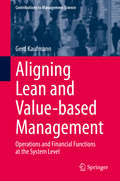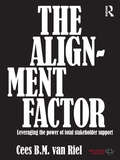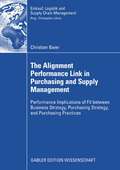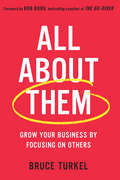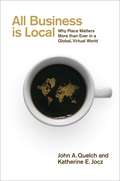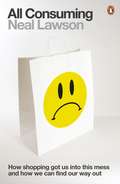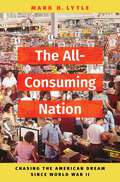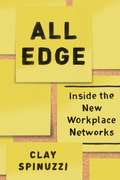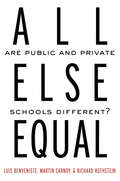- Table View
- List View
Aligning Lean and Value-based Management: Operations and Financial Functions at the System Level (Contributions to Management Science)
by Gerd KaufmannThis book explores the relationship between and the compatibility of lean management (LM) and value-based management (VBM) approaches at the systems level. It then develops a model to improve LM and VBM professional practice by fostering a shared understanding of the value creation process within a lean system, and in doing so helps to remove existing barriers. The results promote future fruitful alliances between a company's operational and financial communities, enhancing the benefits to the enterprise and its stakeholders. The book is of primary interest to LM and VBM professionals and researchers.
Aligning Organizations Through Measurement: The GQM+Strategies Approach (The Fraunhofer IESE Series on Software and Systems Engineering)
by Victor Basili Adam Trendowicz Martin Kowalczyk Jens Heidrich Carolyn Seaman Jürgen Münch Dieter RombachAligning an organization’s goals and strategies requires specifying their rationales and connections so that the links are explicit and allow for analytic reasoning about what is successful and where improvement is necessary. This book provides guidance on how to achieve this alignment, how to monitor the success of goals and strategies and use measurement to recognize potential failures, and how to close alignment gaps. It uses the GQM+Strategies approach, which provides concepts and actionable steps for creating the link between goals and strategies across an organization and allows for measurement-based decision-making.After outlining the general motivation for organizational alignment through measurement, the GQM+Strategies approach is described concisely, with a focus on the basic model that is created and the process for creating and using this model. The recommended steps of all six phases of the process are then described in detail with the help of a comprehensive application example. Finally, the industrial challenges addressed by the method and cases of its application in industry are presented, and the relations to other approaches, such as Balanced Scorecard, are described. The book concludes with supplementary material, such as checklists and guidelines, to support the application of the method.This book is aimed at organization leaders, managers, decision makers, and other professionals interested in aligning their organization’s goals and strategies and establishing an efficient strategic measurement program. It is also interesting for academic researchers looking for mechanisms to integrate their research results into organizational environments.
Aligning Perspectives in Gender Mainstreaming: Gender, Health, Safety, and Wellbeing (Aligning Perspectives on Health, Safety and Well-Being)
by Juliet Hassard Luis D. TorresThis book brings together various threads of research in the field of gender mainstreaming. It aids in further supporting and understanding the role of gender in health and safety research, practice, and policy. It looks at gender mainstreaming as being recognised as key in cultivating sustainable worker health and working systems due to it being a central component of many international policy initiatives. This book deals with gender mainstreaming being advocated at a policy level, while focusing on the limited recognition and discourse on the issue of gender and its direct and indirect association to workers’ health in the field of occupational health and safety. This book addresses problems facing gender-sensitive policies and outlines and reflects upon current best practice principles and practices to support the development and implementation of policies, interventions, and research initiatives.
Aligning the Energy Transition with the Sustainable Development Goals: Key Insights from Energy System Modelling (Lecture Notes in Energy #101)
by George Giannakidis Maryse Labriet Brian Ó Gallachóir Kari EspegrenThis open access book brings together concrete analyses from around the world, spanning various scales, that shed light on strategies for implementing essential energy and climate transitions within the broader context of UN Sustainable Development Goal (SDG) imperatives. Specifically, the book exemplifies the advancement, adaptation, and utilization of energy systems models to address intricate policy issues around pathways to achieve net-zero emissions, enhance energy security, optimize investments, and understand their societal implications. It explores the intricate connections between the SDGs concerning energy, climate action, and other developmental priorities such as employment and economic growth, industrial innovation, urban development, responsible consumption and production, and collaborative partnerships. Organized into four sections, the book illustrates the necessary adjustments of energy system models to guide SDGs, evaluates the role of modeling to advance both renewable energy and energy security, and showcases how energy systems are harnessed to engage with international, national, and local policymakers.
The Alignment Advantage: Transform Your Strategy, Culture and Customers to Succeed
by Richard NugentStrategy, culture and customers are the key elements of any business. But to truly succeed, they need to be effectively built, refined and aligned.Studies show that organizations which are highly aligned are 72% more profitable than their competition. The Alignment Advantage shows how you can achieve this through a practical and proven framework which can be adapted to all businesses, whether it's a small start-up, multinational organization or somewhere in between.Arguing that Simon Sinek's "start with why" approach is compelling yet flawed and Peter Drucker's claim that "culture eats strategy for breakfast" is a myth, Richard Nugent creates a clear, accessible blueprint for a more successful, collaborative and efficient organization. Illustrated with fascinating case studies from the likes of LEGOLAND, Wagamama and The Empire State Building, The Alignment Advantage cuts through organizational silos and inter-departmental tensions to provide an aligned and strategic approach that will allow you to build your success, refine your processes and align your efforts to target your customers and clients.
The Alignment Advantage: Transform Your Strategy, Culture and Customers to Succeed
by Richard NugentStrategy, culture and customers are the key elements of any business. But to truly succeed, they need to be effectively built, refined and aligned.Studies show that organizations which are highly aligned are 72% more profitable than their competition. The Alignment Advantage shows how you can achieve this through a practical and proven framework which can be adapted to all businesses, whether it's a small start-up, multinational organization or somewhere in between.Arguing that Simon Sinek's "start with why" approach is compelling yet flawed and Peter Drucker's claim that "culture eats strategy for breakfast" is a myth, Richard Nugent creates a clear, accessible blueprint for a more successful, collaborative and efficient organization. Illustrated with fascinating case studies from the likes of LEGOLAND, Wagamama and The Empire State Building, The Alignment Advantage cuts through organizational silos and inter-departmental tensions to provide an aligned and strategic approach that will allow you to build your success, refine your processes and align your efforts to target your customers and clients.
The Alignment Factor: Leveraging the Power of Total Stakeholder Support
by Cees B.M. Van RielThe importance of creating a favourable impression is hard to overstate in all walks of life - in business it's vital to achieve strategic goals. Customers, journalists, bloggers, investors, governments and other groups are all important stakeholders in an organizations performance and in persuasively communicating a company's ethical and socially responsible behaviour, these groups can be kept onside. Supported throughout by lively examples, this book contains guidance for implementing strategies that engage stakeholders - highlighting those organizations which employ communication professionals as key performers. Van Riel reveals how a dominant logic develops among executives, which influences styles and techniques of trust-building communication. The practical insights demonstrated via cases including Google, Unilever and Barclays make this book useful reading for MBA and other graduate classes across areas such as public relations and reputation management as well as thinking managers across the globe.
The Alignment Factor: Leveraging the Power of Total Stakeholder Support
by Cees B.M. Van RielThe importance of creating a favourable impression is hard to overstate in all walks of life - in business it's vital to achieve strategic goals. Customers, journalists, bloggers, investors, governments and other groups are all important stakeholders in an organizations performance and in persuasively communicating a company's ethical and socially responsible behaviour, these groups can be kept onside. Supported throughout by lively examples, this book contains guidance for implementing strategies that engage stakeholders - highlighting those organizations which employ communication professionals as key performers. Van Riel reveals how a dominant logic develops among executives, which influences styles and techniques of trust-building communication. The practical insights demonstrated via cases including Google, Unilever and Barclays make this book useful reading for MBA and other graduate classes across areas such as public relations and reputation management as well as thinking managers across the globe.
The Alignment Performance Link in Purchasing and Supply Management: Performance Implications of Fit between Business Strategy, Purchasing Strategy, and Purchasing Practices (Einkauf, Logistik und Supply Chain Management)
by Christian BaierChristian Baier empirically investigates the alignment-performance link in PSM. His findings provide clear guidance to practitioners on how to design their purchasing strategies and practices to achieve maximum alignment and thus effectively contribute to the firm’s competitive advantage.
Alkoholmißbrauch im Betrieb: Personalpolitische und personalrechtliche Problemlösungen
by V. SchäferAll about Them: Grow Your Business by Focusing on Others
by Bruce TurkelThe best companies and most successful salespeople live by a three-word mantra—"all about them"—because when they relentlessly focus their brand on their customers instead of themselves, their businesses flourish. All about Them shows readers how to use this simple but extremely powerful influencing technique. Bruce Turkel, who has advised some of the world's greatest companies, including American Express and Bacardi, lays the groundwork by relating his personal journey of discovery to the "All about Them" principle. He goes on to explore our technology-driven, hyper- connected culture; the power of storytelling (and story-selling); brand authenticity and transparency; and more.
All Above Board: Creating The Ideal Corporate Board
by U. LindgrenBased on unique access interviews with leading chairmen and senior executives, All Above Board examines the key functions of the ideal 21st century board, how and why badly led boards fail, and what changes can be made to improve board behavior and efficiency for best practice.
All Business is Local: Why Place Matters More than Ever in a Global, Virtual World
by John Quelch Katherine JoczWhat's the most important factor in business today? Global competition? Digital development? Or is the age-old concept of 'place' actually the key to success even in todays advanced economy? Marketing experts John Quelch and Katherine Jocz believe that huge opportunities are on offer to marketers and business leaders if they stay focussed on the power of locality. In All Business Is Local, they propose a radically different way of looking at marketing. As society becomes increasingly globalized and obsessed with the virtual world, businesses can easily forget that 'place' is more relevant than ever, and that it remains a major factor in the way we organize our lives.Radically redefining 'place' as a business imperative in the global economy, Quelch and Jocz explore five categories (psychological, physical, virtual, geographical and global) and teach us that just as customers' relationships to places profoundly affect their relationships to businesses, today's companies - large and small - have to be local as well as global in order to succeed.
All Change at Work?: British Employment Relations 1980-98, Portrayed by the Workplace Industrial Relations Survey Series
by Alex Bryson John Forth Neil MillwardThis book is the latest publication reporting the results of a series of workplace surveys conducted by the Department of Trade and Industry, the Economic and Social Research Council, the Advisory Conciliation and Arbitration Service and the Policy Studies Institute. It addresses such contemporary employee relations issues as: * Have new configurations of labour-management practices become embedded in the British economy? * Did the dramatic decline in trade union representation in the 1980s continue throughout the 1990s, leaving more employees without a voice? * Are the vestiges of union organisation at the workplace a hollow shell? The focus of this book is on change, captured by gathering together the enormous bank of data from all four of the large-scale and highly respected surveys, and plotting trends from 1980 to the present. In addition, a special panel of workplaces, surveyed in both 1990 and 1998, reveals the complex processes of change. Comprehensive in scope, the results are statistically reliable and reveal the nature and extent of change in all bar the smallest British workplaces. A key text for anyone interested in employment and the changing world of work, whether as student, researcher, teacher, analyst, adviser or practitioner.
All Change at Work?: British Employment Relations 1980-98, Portrayed by the Workplace Industrial Relations Survey Series
by Alex Bryson John Forth Neil MillwardThis book is the latest publication reporting the results of a series of workplace surveys conducted by the Department of Trade and Industry, the Economic and Social Research Council, the Advisory Conciliation and Arbitration Service and the Policy Studies Institute. It addresses such contemporary employee relations issues as: * Have new configurations of labour-management practices become embedded in the British economy? * Did the dramatic decline in trade union representation in the 1980s continue throughout the 1990s, leaving more employees without a voice? * Are the vestiges of union organisation at the workplace a hollow shell? The focus of this book is on change, captured by gathering together the enormous bank of data from all four of the large-scale and highly respected surveys, and plotting trends from 1980 to the present. In addition, a special panel of workplaces, surveyed in both 1990 and 1998, reveals the complex processes of change. Comprehensive in scope, the results are statistically reliable and reveal the nature and extent of change in all bar the smallest British workplaces. A key text for anyone interested in employment and the changing world of work, whether as student, researcher, teacher, analyst, adviser or practitioner.
All-Change in the City: The Revolution in Britain’s Financial Sector
by Margaret ReidAn analysis placing London in its global setting and tracing with new detail, the origins of the "Big Bang". It attempts to analyze the less familiar evolution of city institutions, including the big banks whose business is examined with particular emphasis on the Bank of England.
All Consuming: How Shopping Got Us Into This Mess And How We Can Find Our Way Out
by Neal Lawson'Stabbing at battle of Ikea' Sun'Most expensive house has £390m price tag' Daily Telegraph'Financier runs up £36,000 bar bill' IndependentDiamond-encrusted phones, waiting lists for handbags, 7-star hotels - in the summer of 2007, the UK economy finally reached its giddy peak. But it wasn't just celebrities and bankers wanting to spend, spend, spend. Whipping out our cheap credit cards, the whole nation developed one obsessive, unsustainable habit: shopping.Now the cash has dried up and we've consumed our way to financial disaster. But were rich times really happy times? And if shopping got us in to this mess, should we really be encouraged to shop our way out of it?With finances in flux, now is our chance to break this all-consuming cycle. Offering everyday ways to start kicking the habit, Neal Lawson shows us how to put the basket down for good, and why we'll be happier for it.
The All-Consuming Nation: Chasing the American Dream Since World War II
by Mark H. LytleIn his 1958 "kitchen debate" with Nikita Khrushchev, Richard Nixon argued that the freedom to consume defined the American way of life. High wages, full employment, new technologies, and a rapid growth in population known as the "Baby Boom" ushered in a golden age of economic growth. By the end of the twentieth century, consumerism triumphed over communism, socialism, and all other isms seeking to win hearts and minds around the world. Advertising, popular culture, and mass media persuaded Americans that shopping was both spiritually fulfilling and a patriotic virtue. Mark Lytle argues that Nixon's view of consumer democracy contained fatal flaws -- if unregulated, it would wholly ignore the creativedestruction that, in destroying jobs, erodes the capacity to consume. The All-Consuming Nation also examines how planners failed to take into account the environmental costs, as early warning signs--whether smog over Los Angeles, the overuse of toxic chemicals such as DDT, or the Cuyahoga River in flames--provided evidence that all was not well. Environmentalists from Aldo Leopold, Rachel Carson and Paul Ehrlich to Ralph Nader and Al Gore cautioned that modern consumerism imposed unsustainable costs on the natural world. Not for lack of warning, climate change became the defining issue of the twenty-first century. The All-Consuming Nation investigates the environmental and sociocultural costs of the consumer capitalism framework set in place in the 20th century, shedding light on the consequences of a national identity forged through mass consumption.
The All-Consuming Nation: Chasing the American Dream Since World War II
by Mark H. LytleIn his 1958 "kitchen debate" with Nikita Khrushchev, Richard Nixon argued that the freedom to consume defined the American way of life. High wages, full employment, new technologies, and a rapid growth in population known as the "Baby Boom" ushered in a golden age of economic growth. By the end of the twentieth century, consumerism triumphed over communism, socialism, and all other isms seeking to win hearts and minds around the world. Advertising, popular culture, and mass media persuaded Americans that shopping was both spiritually fulfilling and a patriotic virtue. Mark Lytle argues that Nixon's view of consumer democracy contained fatal flaws -- if unregulated, it would wholly ignore the creativedestruction that, in destroying jobs, erodes the capacity to consume. The All-Consuming Nation also examines how planners failed to take into account the environmental costs, as early warning signs--whether smog over Los Angeles, the overuse of toxic chemicals such as DDT, or the Cuyahoga River in flames--provided evidence that all was not well. Environmentalists from Aldo Leopold, Rachel Carson and Paul Ehrlich to Ralph Nader and Al Gore cautioned that modern consumerism imposed unsustainable costs on the natural world. Not for lack of warning, climate change became the defining issue of the twenty-first century. The All-Consuming Nation investigates the environmental and sociocultural costs of the consumer capitalism framework set in place in the 20th century, shedding light on the consequences of a national identity forged through mass consumption.
All The Devils Are Here: Unmasking the Men Who Bankrupted the World
by Bethany McLean Joe NoceraAccording to Bethany McLean and Joe Nocera, two of America's most acclaimed business journalists, no-one has put all the pieces of the financial crisis together. The finger was pointed at greedy traders, cowardly legislators and clueless home buyers, but many devils helped bring hell to the economy.All The Devils Are Here goes back several decades to explore the motivations of everyone from CEOs and politicians to anonymous lenders, borrowers and Wall Street traders. It exposes the hidden role of companies including AIG and Goldman Sachs. It delves into the powerful mythology of homeownership. And it proves that the crisis ultimately wasn't about finance at all; it was about human nature.Bethany McLean's The Smartest Guys in the Room was the best Enron book on a crowded shelf. All the Devils Are Here will be remembered for finally making sense of the meltdown.
All Edge: Inside the New Workplace Networks
by Clay SpinuzziWork is changing. Speed and flexibility are more in demand than ever before thanks to an accelerating knowledge economy and sophisticated communication networks. These changes have forced a mass rethinking of the way we coordinate, collaborate, and communicate. Instead of projects coming to established teams, teams are increasingly converging around projects. These “all-edge adhocracies” are highly collaborative and mostly temporary, their edge coming from the ability to form links both inside and outside an organization. These nimble groups come together around a specific task, recruiting personnel, assigning roles, and establishing objectives. When the work is done they disband their members and take their skills to the next project. Spinuzzi offers for the first time a comprehensive framework for understanding how these new groups function and thrive. His rigorous analysis tackles both the pros and cons of this evolving workflow and is based in case studies of real all-edge adhocracies at work. His provocative results will challenge our long-held assumptions about how we should be doing work.
All Edge: Inside the New Workplace Networks
by Clay SpinuzziWork is changing. Speed and flexibility are more in demand than ever before thanks to an accelerating knowledge economy and sophisticated communication networks. These changes have forced a mass rethinking of the way we coordinate, collaborate, and communicate. Instead of projects coming to established teams, teams are increasingly converging around projects. These “all-edge adhocracies” are highly collaborative and mostly temporary, their edge coming from the ability to form links both inside and outside an organization. These nimble groups come together around a specific task, recruiting personnel, assigning roles, and establishing objectives. When the work is done they disband their members and take their skills to the next project. Spinuzzi offers for the first time a comprehensive framework for understanding how these new groups function and thrive. His rigorous analysis tackles both the pros and cons of this evolving workflow and is based in case studies of real all-edge adhocracies at work. His provocative results will challenge our long-held assumptions about how we should be doing work.
All Edge: Inside the New Workplace Networks
by Clay SpinuzziWork is changing. Speed and flexibility are more in demand than ever before thanks to an accelerating knowledge economy and sophisticated communication networks. These changes have forced a mass rethinking of the way we coordinate, collaborate, and communicate. Instead of projects coming to established teams, teams are increasingly converging around projects. These “all-edge adhocracies” are highly collaborative and mostly temporary, their edge coming from the ability to form links both inside and outside an organization. These nimble groups come together around a specific task, recruiting personnel, assigning roles, and establishing objectives. When the work is done they disband their members and take their skills to the next project. Spinuzzi offers for the first time a comprehensive framework for understanding how these new groups function and thrive. His rigorous analysis tackles both the pros and cons of this evolving workflow and is based in case studies of real all-edge adhocracies at work. His provocative results will challenge our long-held assumptions about how we should be doing work.
All Edge: Inside the New Workplace Networks
by Clay SpinuzziWork is changing. Speed and flexibility are more in demand than ever before thanks to an accelerating knowledge economy and sophisticated communication networks. These changes have forced a mass rethinking of the way we coordinate, collaborate, and communicate. Instead of projects coming to established teams, teams are increasingly converging around projects. These “all-edge adhocracies” are highly collaborative and mostly temporary, their edge coming from the ability to form links both inside and outside an organization. These nimble groups come together around a specific task, recruiting personnel, assigning roles, and establishing objectives. When the work is done they disband their members and take their skills to the next project. Spinuzzi offers for the first time a comprehensive framework for understanding how these new groups function and thrive. His rigorous analysis tackles both the pros and cons of this evolving workflow and is based in case studies of real all-edge adhocracies at work. His provocative results will challenge our long-held assumptions about how we should be doing work.
All Else Equal: Are Public and Private Schools Different?
by Luis Benveniste Martin Carnoy Richard RothsteinPrivate schools always provide a better education than public schools. Or do they? Inner-city private schools, most of which are Catholic, suffer from the same problems neighboring public schools have including large class sizes, unqualified teachers, outdated curricula, lack of parental involvement and stressful family and community circumstances. Straightforward and authoritative, All Else Equal challenges us to reconsider vital policy decisions and rethink the issues facing our current educational system.
